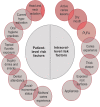Arginine: A New Paradigm in Preventive Oral Care
- PMID: 38162235
- PMCID: PMC10753110
- DOI: 10.5005/jp-journals-10005-2693
Arginine: A New Paradigm in Preventive Oral Care
Abstract
Dental caries is ubiquitous and one of the most prevalent oral diseases and the foremost cause of dental pain and poor quality of life (QoL). Fluoride is an effective caries preventive agent; however, despite its use, there remain some gaps in prevention of dental caries. Arginine, an amino acid, helps to maintain a noncariogenic plaque. It shows synergistic effects with fluoride in dental caries and can help nourish the tooth by enhancing the remineralization effect of fluoride. Supplementing fluoride dentifrices with arginine can bridge the gap in caries prevention. Several clinical studies with 1.5% arginine + fluoride provide evidence for its use in prevention of dental caries. This report throws light on the benefits of arginine in dental caries and guides on its use with fluoride. Recommendations given in the report will help in effective prevention of dental caries.
How to cite this article: Goyal V, Damle S, Puranik MP, et al. Arginine: A New Paradigm in Preventive Oral Care. Int J Clin Pediatr Dent 2023;16(5):698-706.
Keywords: Arginine; Dental caries; Fluoride.
Copyright © 2023; The Author(s).
Conflict of interest statement
Source of support: Nil Conflict of interest: None
Figures




Similar articles
-
Functional changes in the oral microbiome after use of fluoride and arginine containing dentifrices: a metagenomic and metatranscriptomic study.Microbiome. 2022 Sep 28;10(1):159. doi: 10.1186/s40168-022-01338-4. Microbiome. 2022. PMID: 36171634 Free PMC article.
-
The development and validation of a new technology, based upon 1.5% arginine, an insoluble calcium compound and fluoride, for everyday use in the prevention and treatment of dental caries.J Dent. 2013 Aug;41 Suppl 2:S1-11. doi: 10.1016/j.jdent.2010.04.002. J Dent. 2013. PMID: 23985433 Review.
-
Fluoride toothpaste containing 1.5% arginine and insoluble calcium as a new standard of care in caries prevention.J Clin Dent. 2013;24(3):79-87. J Clin Dent. 2013. PMID: 24660269
-
A clinical investigation of the efficacy of a dentifrice containing 1.5% arginine and 1450 ppm fluoride, as sodium monofluorophosphate in a calcium base, on primary root caries.J Clin Dent. 2013;24 Spec no A:A23-31. J Clin Dent. 2013. PMID: 24156137 Clinical Trial.
-
Comparing the Effectiveness of Topical Fluoride and Povidone Iodine with Topical Fluoride Alone for the Prevention of Dental Caries among Children: A Systematic Review and Meta-analysis.Int J Clin Pediatr Dent. 2020 Sep-Oct;13(5):559-565. doi: 10.5005/jp-journals-10005-1844. Int J Clin Pediatr Dent. 2020. PMID: 33623347 Free PMC article. Review.
Cited by
-
Evaluation of the Antibacterial and Anti-Biofilm Activity of Chitosan-Arginine Nanoparticles and Sodium Fluoride against Streptococcus mutans.Int J Mol Cell Med. 2025 Jul 1;14(2):637-645. doi: 10.22088/IJMCM.BUMS.14.2.637. eCollection 2025. Int J Mol Cell Med. 2025. PMID: 40765761 Free PMC article.
-
Novel L-(CaP-ZnP)/SA Nanocomposite Hydrogel with Dual Anti-Inflammatory and Mineralization Effects for Efficient Vital Pulp Therapy.Int J Nanomedicine. 2024 Jul 3;19:6659-6676. doi: 10.2147/IJN.S464871. eCollection 2024. Int J Nanomedicine. 2024. PMID: 38975320 Free PMC article.
References
-
- Kassebaum NJ, Smith AGC, Bernabé E, et al. Global, regional, and national prevalence, incidence, and disability-adjusted life years for oral conditions for 195 countries, 1990-2015: a systematic analysis for the global burden of diseases, injuries, and risk factors. J Dent Res. 2017;96(4):380–387. doi: 10.1177/0022034517693566. - DOI - PMC - PubMed
LinkOut - more resources
Full Text Sources
Miscellaneous
